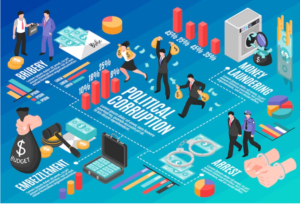How technology is used to solve crimes

Since the days of Sherlock Holmes and magnifying glasses, people have learned a lot about how to solve crimes. Technology is a big part of how police in the United States solve crimes these days. From forensic science to big data analytics, technology has changed how crimes are probed and solved. And let’s be honest, who doesn’t like a good story about how a crime is solved?
As technology has grown, it has become harder for thieves to get away from the law. Law enforcement organisations find new and creative ways to use technology to fight crime every day. From DNA analysis to predictive police, technology has helped the US fight crime in a big way. And since cybercrime is getting worse, police are now using technology to find crooks in the digital world. It’s like the Wild West, except that people use computers instead of guns.
So, if you want to know how technology is used to solve crimes in the United States, get ready for a wild ride. In this blog, we’ll talk about how law enforcement uses technology and how it has helped solve crimes. We’ll talk about everything, from the important to the silly. Let’s get started!
Forensic sciences
In the past few years, forensic science has come a long way, and technology has played a big role in this. In the USA, technology has changed the way that DNA analysis, fingerprint analysis, and ballistics analysis are used to gather and analyse data. With the help of new technologies, forensic scientists can now collect more accurate and detailed proof than ever before. This has led to more successful convictions and exonerations. DNA analysis, in particular, has changed the game because it helps police match suspects to crime scenes with a level of accuracy that has never been seen before. Also, improvements in technology have helped fingerprint and ballistics analysis, which makes it easier for forensic scientists to identify suspects and guns. As technology keeps getting better, it’s exciting to think about what it could mean for forensic science and solving crimes in the United States.
Surveillance technology is a hotly discussed topic. Those who support it say it’s an important tool for solving crimes, while those who don’t say it invades people’s privacy. In the United States, police use CCTV cameras, drones, and licence plate readers, among other surveillance technologies, to gather proof and find out who the suspects are. All kinds of crimes, from burglaries to murders, have been solved with the help of these tools. But some people worry about the ethical effects of monitoring technology, especially when it comes to privacy invasion. Critics say that monitoring that isn’t checked can lead to power abuses and violations of civil rights. It’s hard to find a good balance between public safety and personal privacy, and the discussion over the use of surveillance technology is likely to go on for years.
Big data analytics
Big data analytics has changed the way police departments in the United States solve crimes. By looking at a huge amount of information, like criminal records and posts on social media, law enforcement can find trends and predict future criminal activity. For example, predictive police uses algorithms to look at crime data and figure out where and when crimes are most likely to happen. This helps law enforcement use their resources more effectively. Social media research is also being used more and more to look for possible threats and solve crimes. Big data analytics are also used in the area of facial recognition technology, which is used by police to identify criminals in real time. Even though there are worries about privacy and civil rights, no one can deny that big data analytics could help solve crimes.
Cybercrime:
Cybercrime is becoming more and more common as technology gets better. Cybercrimes like hacking, identity theft, and online fraud are becoming more and more popular in the United States. Law enforcement organisations are also using technology to fight these crimes, which is a good thing. Cybercrime investigations often involve complicated digital forensics, such as getting data back from electronic devices and finding out where cyber attacks came from. Cybercrime is also investigated by special teams that use cutting-edge technology to track down and identify suspects. Cybercrime can also be found and stopped with the help of big data analytics and machine learning. With the rise of cybercrime, technology will continue to be a key part of law enforcement’s attempts to stop this threat that is always changing.
Mobile technology
The way police solve crimes in the United States has changed because of mobile technology. Smartphones and GPS tracking devices are powerful tools that law enforcement has been using more and more to find suspects and collect proof. Cell phone data, for example, can tell a lot, like where the phone was at the time of a crime, what calls and texts were made, and even what websites were visited. GPS tracking devices are also used to track the movements of suspects. This helps law enforcement create a timeline of events and gather proof for criminal investigations. Because mobile technology is so common, it has become an essential tool for law enforcement in the fight against crime.
In conclusion, technology has changed a lot about how law enforcement agents in the United States solve crimes. From big data analytics to mobile technology, the use of technology has helped law enforcement agencies gather evidence, track down suspects, and predict future criminal behaviour. But there are also worries about what these technologies mean for ethics, especially when it comes to privacy and civil rights.
Even though there could be problems, the future of using technology to solve crimes looks good. For example, progress in artificial intelligence and machine learning could make law enforcement even more accurate and effective. Also, the growth of new technologies like quantum computing may open up new ways to solve crimes that were once thought to be impossible.
As technology keeps getting better, it’s important for law enforcement agents to weigh the pros and cons of what it can do. The end goal of using technology to solve crimes should be to make people safer while still respecting their rights and freedoms. By finding this balance, technology can help make communities safer and help victims of crime get justice.
Read More You May Like:
- How communities can effectively prevent crime through cooperation
- Examining the effects of trauma and social inequality on criminal behavior
- Delving into the root causes of rising crime rates
- Analyzing the effect of incarceration on crime rates
- Understanding the relationship between poverty and crime rates








